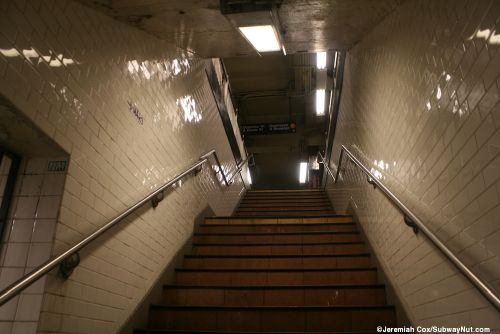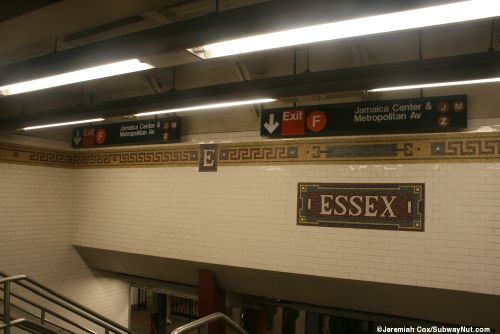














Essex Street is the BMT subway station at the foot of the Williamsburg Bridge that opened in 1908 and the station has a unique layout with 3 tracks and two platforms, one side platform and one island platform on the northern edge of the abandoned underground Essex Street Trolley Terminal that once served the turning loops of streetcars going over the bridge. The station is just beneath the surface. The Trolley Terminal has largely survived intact with only a tiny portion turned into subway storerooms as a large and relatively well lit underground space. The MTA is currently assessing proposals for alternative non-transportation uses inside of it.
The side platform is for the single north track used by trains coming off of the Williamsburg Bridge and not terminating in the station (weekend M trains). Since the combination of the M/V via the Chrystie Street Connection in 2010 this platform has the not-quite-right looking signs for Uptown M | Downtown J/Z. This side platform has the usual tiled walls that were redone with renovations in 2004. The walls have a golden trimline with accents of green and brown. There are little Es on a brown background. Small name tablets (including one vertically) are beneath this trimline. There also the little Es with brown backgrounds and gold and green borders.
The island platform has two tracks and is used by all trains going over the Williamsburg Bridge. Since the former northbound tracks in the Centre Street Subway were closed in 2004 normally J/Z trains stop on the middle track, although switches do allow them to also use the outside track (facing the former Trolley Terminal). M trains, coming from the 6th Avenue line via the Chrystie Street connection have to use the outside tracks from their flying junction entrance (even though their coming from farther north) and take a different route (following Chrystie Street along the B,D express tracks) completely away from the 2 Avenue Station F trains stop. Brooklyn-bound M and J/Z trains sometimes make cross-platform transfers at Essex Street but since the Williamsburg Bridge only has two tracks, one train must always leave first.
On June 8, 2014, weekend daytime M trains were extended from their usual shuttle ending at Myrtle Avenue-Broadway to terminate at Essex Street (and provide a transfer to the F train for 6 Avenue service). This was the first time since elevated trains stopped crossing the Brooklyn Bridge in 1944 that the that stations between Myrtle Avenue-Broadway and Middle Village received direct weekend service to Manhattan (M trains used to be extended to Manhattan only on weekends when L train service between Manhattan or Brooklyn was suspended do to track work). This service change made the side of the island platform J or M trains stop at different depending upon if it is a weekend or a weekday. Weekend terminating M trains now stop on the middle track. Jamaica-bound J trains now use the outside track on weekends so they can pass relaying M trains in the station on layovers. There is a bunch of signage indicating that Brooklyn-bound J and M trains stop on different sides of the platform depending upon the day of the week, plus a number of signs telling Weekend M train riders to wait in the middle of the platform for the 4 car basically extended shuttle train that operates using One Person Train Operation (OPTO).
The IND F train's Delancey Street station is just beneath the eastern end of the platforms. All access to Williamsburg Bridge-bound island platform is via the lower-level F platforms that act as an underpass, but have very wide central areas so passengers can leave the J/M/Z platform and not be interspersed with passengers waiting and boarding F trains. This platform is quite narrow with a single line of columns along the middle J/Z track. Towards the eastern end of the platform is a closed emergency exit staircase that leads downstairs. At the western end is where the only exits are. There are two staircases down to the Uptown F platform, followed by 2 down to the Downtown platform at its extreme western end. At this area are signs that say "Do Not Wait Here" with arrows to try and funnel passengers towards the front of the narrow platform. The track along the platform lacks a wall except at its western end allowing a view into the abandoned trolley terminal beyond.
The Uptown-Downtown Platform has its own exit along the exact middle of the platform. Here is a narrow fare control area with a token booth and two separate sets of turnstiles. It leads out to two streetstairs: one to the NE corner of Essex and Norfolk Streets, and one near the NW corner slightly down the Essex Street block. At the eastern end of the platform is a staircase directly down to the Uptown F platform. Passengers wanting stations along Sixth Avenue and not caring if they catch the F or the M train have a habit of standing on the staircase so they can see whichever train comes first and rush up or down to the respective platform causing crowding. This is followed by a very wide staircase that leads down to a shared fare control area with the F train (see the Delancey Street page for photos and full information) and a staircase down to the Uptown and Downtown F side platforms.
The station has further abandoned exits, including closed off additional stairs that once led up to the north side of long Delancey Street between Suffolk and Norfolk Street (and on platform fare control) at the eastern end of the Uptown/Downtown platform. The Brooklyn-bound island platform has a former exit accessed via the emergency exit on platform staircase and is used by employees that leads to a short underpass under the southern station track (there isn’t an underpass here to the Uptown/Downtown platform) and to a former fare control area in the small portion of the trolley terminal that has been taken over for employee uses, it once led to streetstairs to the SE and SW corners of Norfolk and Delancey Streets.
1 & 2: February 3, 2004; 3-11: December 31, 2008; 12-18: August 25, 2010; 19 & 20: November 4, 2013; 21-40: March 6, 2013; 41-44: May 12, 2013; 45-54: June 15, 2014


Station Subway Lines (1988-2010)


